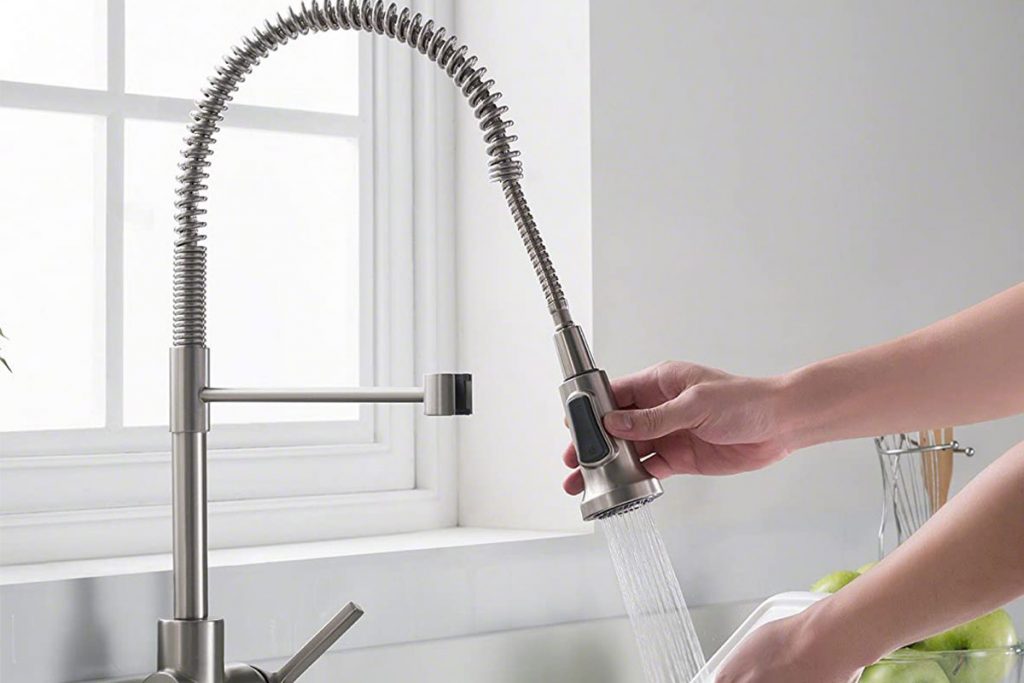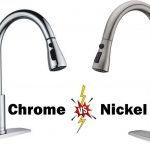The faucet is an essential part of any restaurant and commercial kitchen. In this case, a pre-rinse faucet is a wonderful choice.
If you have never heard about this name, this blog is for you! Scroll down to learn what is a pre-rinse kitchen faucet and how it functions. Let’s find out more in this post now!
Features Of Pre-Rinse Kitchen Faucets

Considering the features of pre-rinse kitchen faucets will help you easily choose an appropriate one for your kitchen. Below are some typical features for your reference.
Types of Style
Pre-rinse kitchen faucets include two common types of style: roto-flex and gooseneck faucets.
- Roto-flex style is flexible, enabling you to easily move the tap around by using the elbow connections.
- Gooseneck style is stationary. You can move the directional position, however, using a spring included. The gooseneck is common in lots of houses.
Built-in Features
The first thing that will catch your eyes about the pre-rinse kitchen faucet is its eye-catching look. It will make your kitchen shine and is more luxurious than ever.
Also, it includes an arc spout of high quality. It helps to generate a strong spray pressure so that users can blast grease-filled on their plates. Pre-rinse faucets are also terrific for blasting silverware and cutlery.
Self-cleaning spray heads are one of the best features of the faucets, as they allow you to get rid of dish soap which is especially suitable for those with sensitive skin.
Other Features
There exist several optional features that you can add to your cart and make a separate purchase.
- Spray valves come in different types with different rates of flow. Flow rates are usually measured by gallons every minute (GPM), expressing the rate water streams through. High low-water rate valves will generate a much stronger amount of water.
- Pin-down rings help to keep sprayer valves open. Otherwise, user fatigues will occur after a long period of use.
- Foot valves, wrist handles, and club handles are great optional features to replace the usual ones.
- Swivel faucets are a nice base attachment of the pre-rinse kitchen faucet.
- Small pre-rinse kitchen faucets are proper alternatives for the tall versions and are suitable for those who want more space in their washing place.
- Stainless steel pre-rinse faucets are for those who would like high-end models for their kitchens.
Pros And Cons
Learning about the pros and cons of pre-rinse kitchen faucets enables you to choose out a suitable option for your kitchen.
Pros
Here are some good points of a pre-rinse kitchen faucet. Let’s go through them now to see how terrific this faucet type is!
- A pre-rinse kitchen faucet is eye-catching with its visual appeal and modern style. To be more specific, it looks perfect and luxurious for both commercial kitchens and household kitchens.
- It is perfect for blasting tough dirty plates much faster than the regular one can do.
- Its tall height helps to deal with extra-large pans and pots with ease.
- Ease of cleaning. You can easily clean out all grease and residue after cooking without spending too much time.
- In general, most pre-rinse products are super durable that can last over a long period of time. Thanks to their durability, there is no need to spend money on replacing new ones.
- With an installation kit, it only takes you around less than two hours to finish the installation.
Cons
Besides the advantages, pre-rinse faucets also have some minor disadvantages.
- Pre-rinse kitchen faucets can cost around $650 – $ 1,200 for each unit, making them pricey investments.
- The tall height of the faucet makes it impossible to equip the overhead cabinet.
- Pre-rinse faucets are not water efficient.
How Do Pre-Rinse Faucets Work?
It is important to learn how this faucet works. In that way, you will use it as effectively as possible.
The gooseneck style is ideal for pre-rinsing and a single or double compartment sink. Particularly, its overhead support spring holds the hose in an upright position as it is pulled down during use.
Designed to make operation easier by gliding during use, the roto-flex design allows for smooth movement and quick reaction when not in use.
Providing enhanced protection for the hose, the overhead swivel arm configuration features an arm at the top of a riser that swivels. This allows the hose to move freely back-and-forth spraying into numerous areas below.
With more than five feet of available hose reach in any direction, the tall riser on the balancer style supports the hose overhead, providing maximum range of motion for multipurpose use.
Designed for compact kitchens and other areas where space is at a premium, the low-profile configuration is ideal for general pre-rinsing when overhead clearance is limited.
For tasks such as filling sinks or pots, the big flow units deliver large amounts of water quickly – featuring inlets and nozzles with no restrictions on add-on faucets.
How Much Will It Cost To Install A Pre-Rinse Kitchen Faucet?
The prices are different between companies, but usually, they cost around $297 – $333 for each faucet installation. Those prices apply only for bulk installations of six faucets. For single installations, they may cost more than that.
For pre-rinse kitchen faucets in the range of around $650-$1,200, buyers may need to pay from $947 to $1,533 for the whole package. The replacement cost for this type of faucet is quite similar to its installation cost.
Conclusion
The post has shown you a clear answer for the question what is a pre-rinse kitchen faucet?
In short, pre-rinse kitchen faucets come in two styles, including roto-flex faucets and gooseneck faucets. Each style has its pros and cons and varies in price. You can choose a suitable one depending either on the purpose of use or price range.




